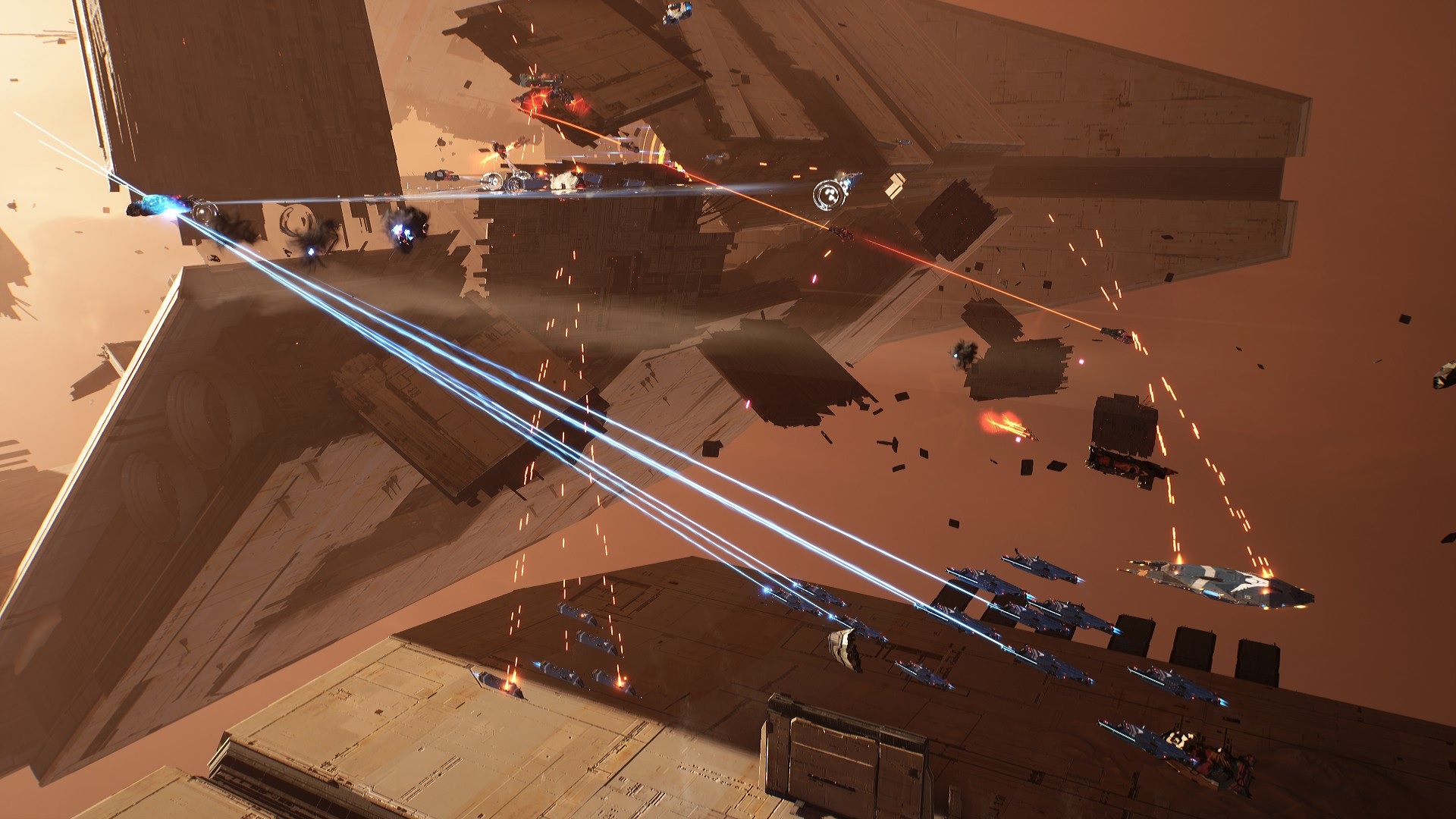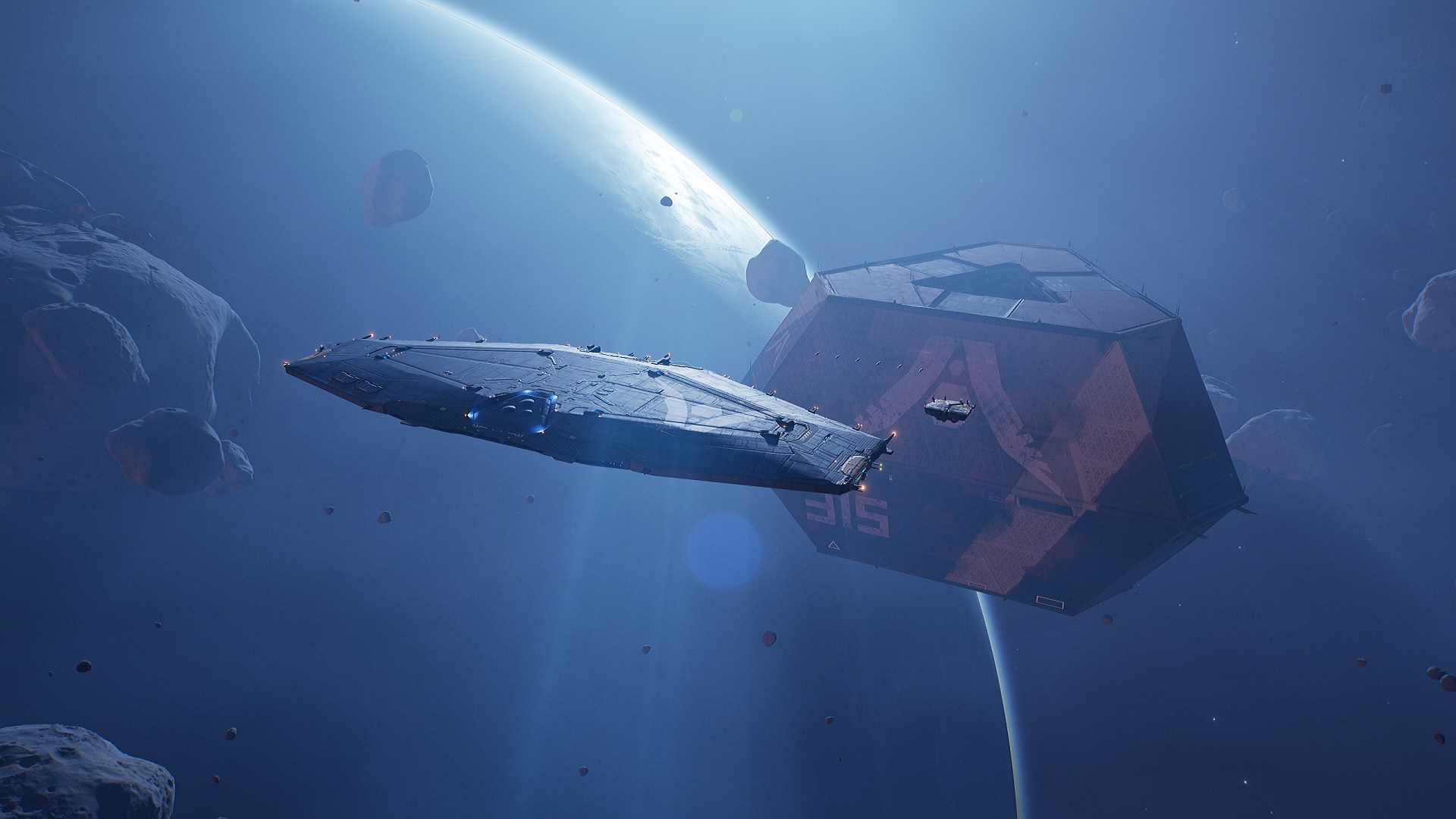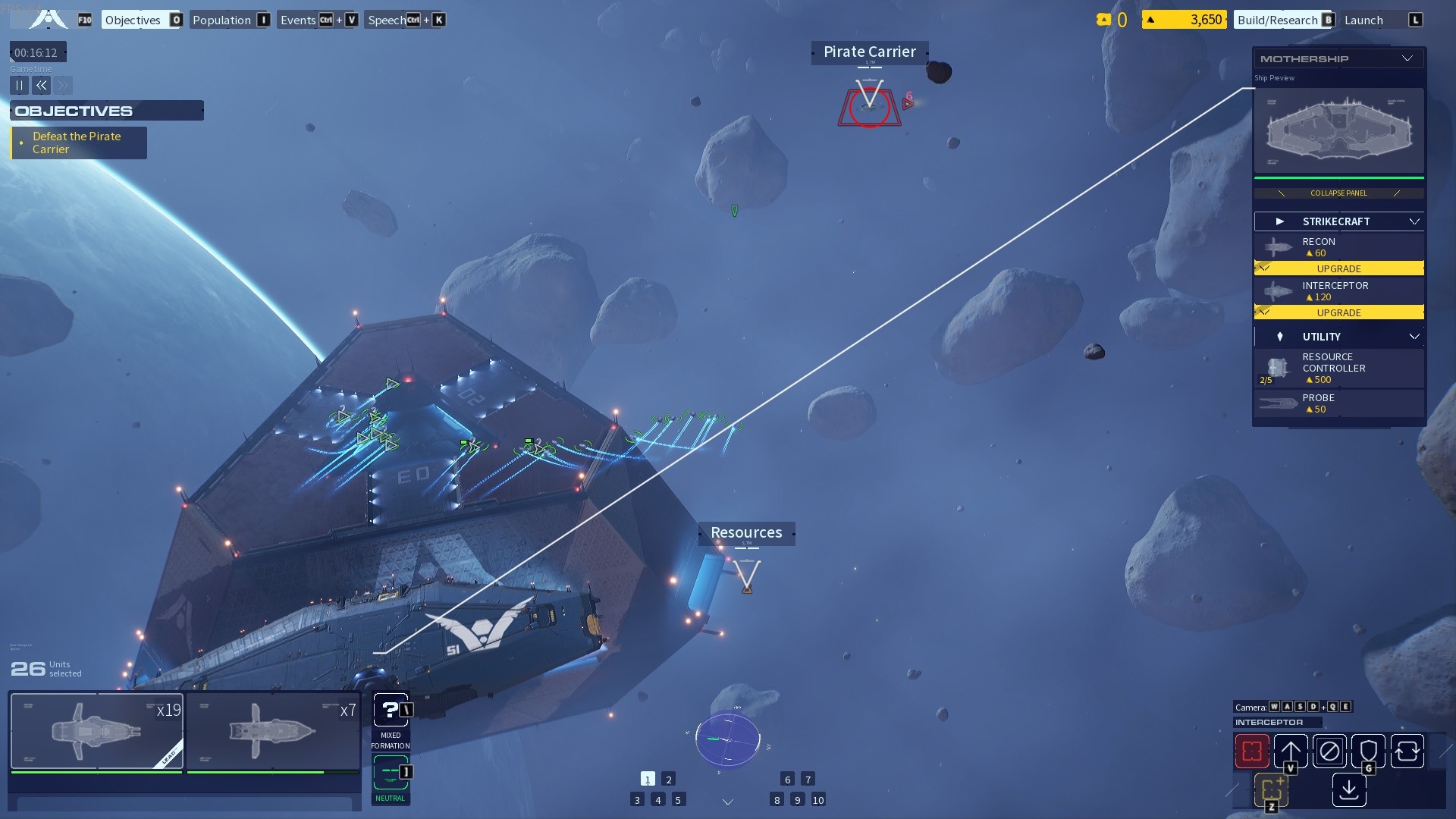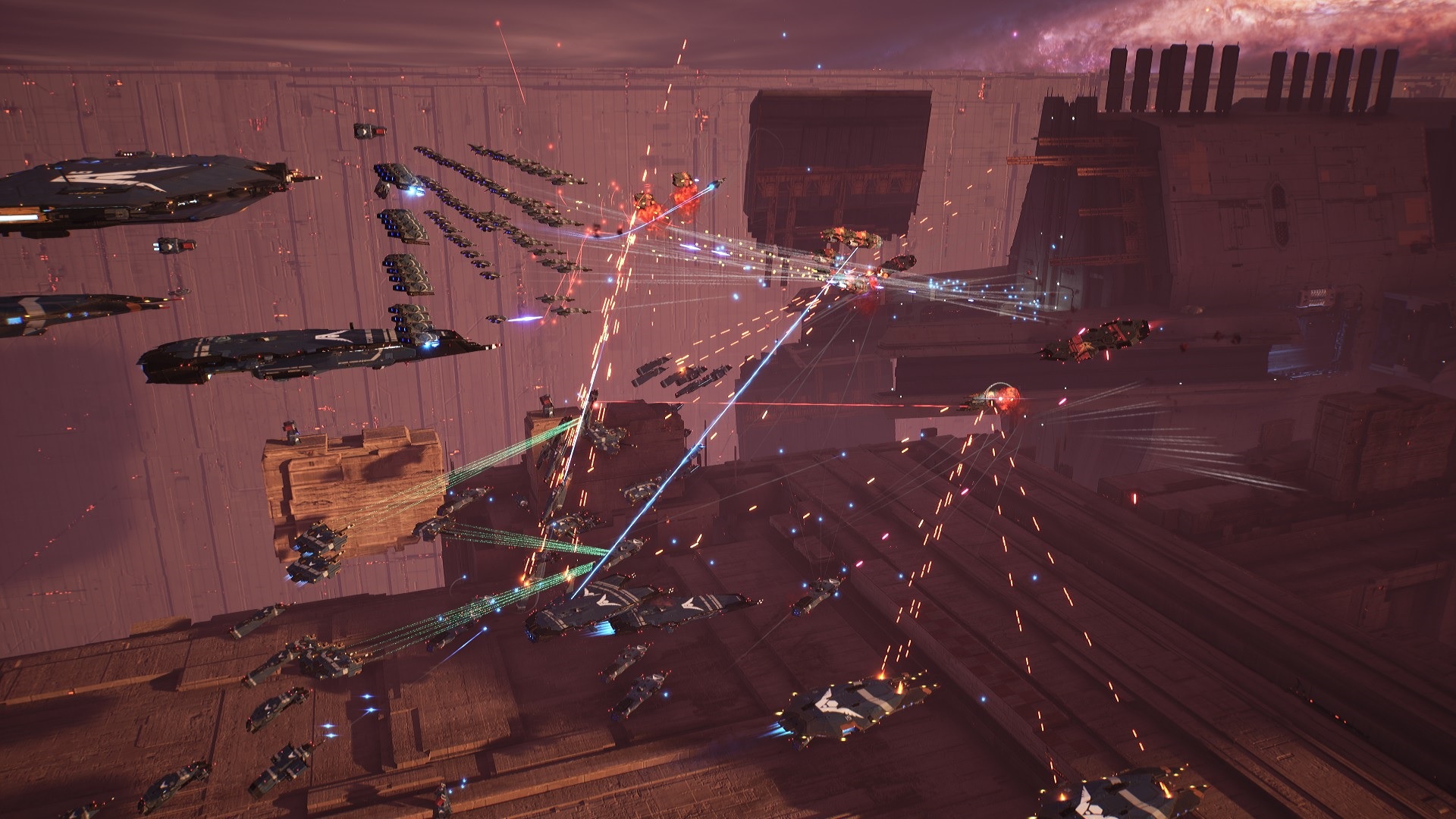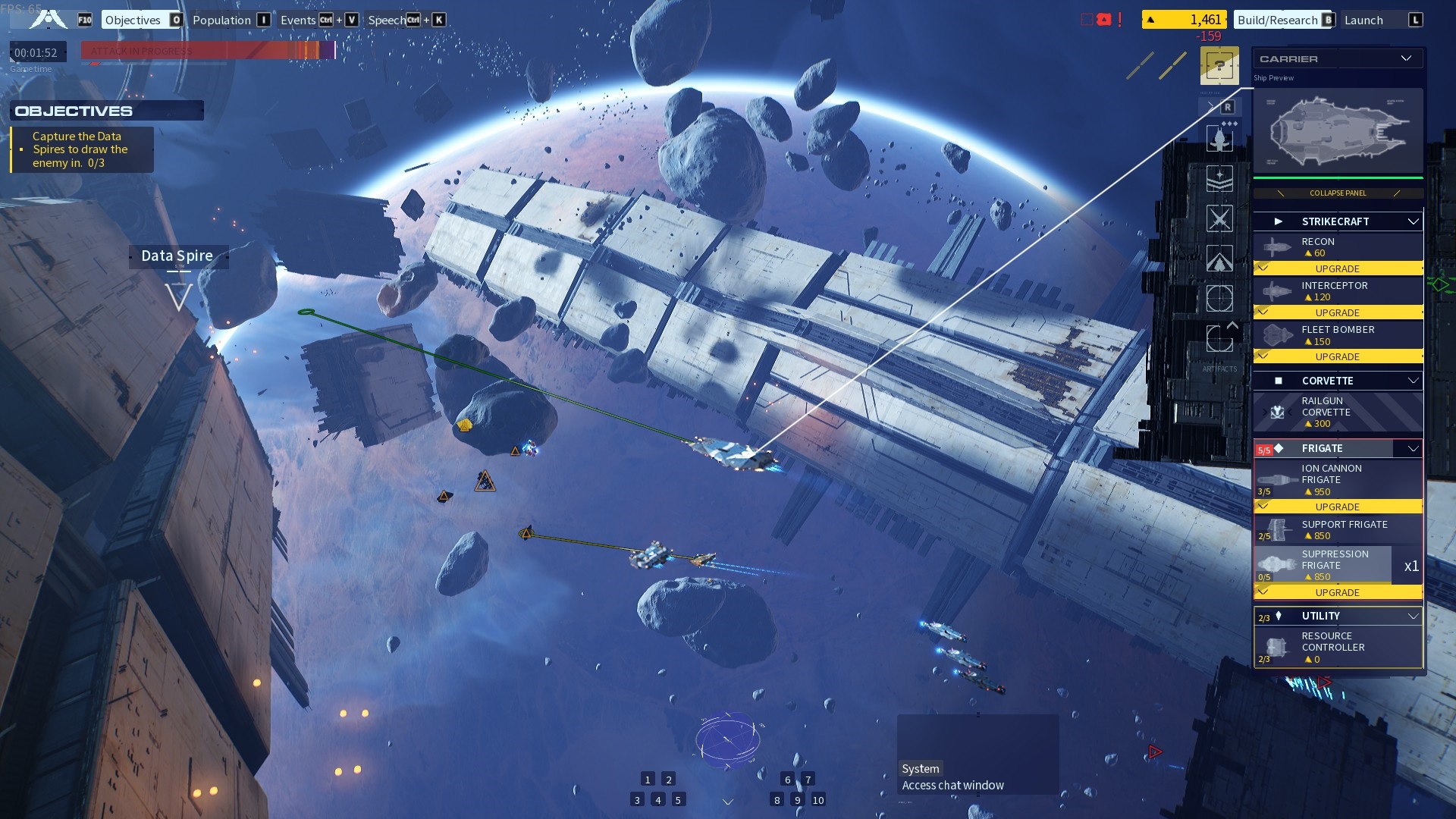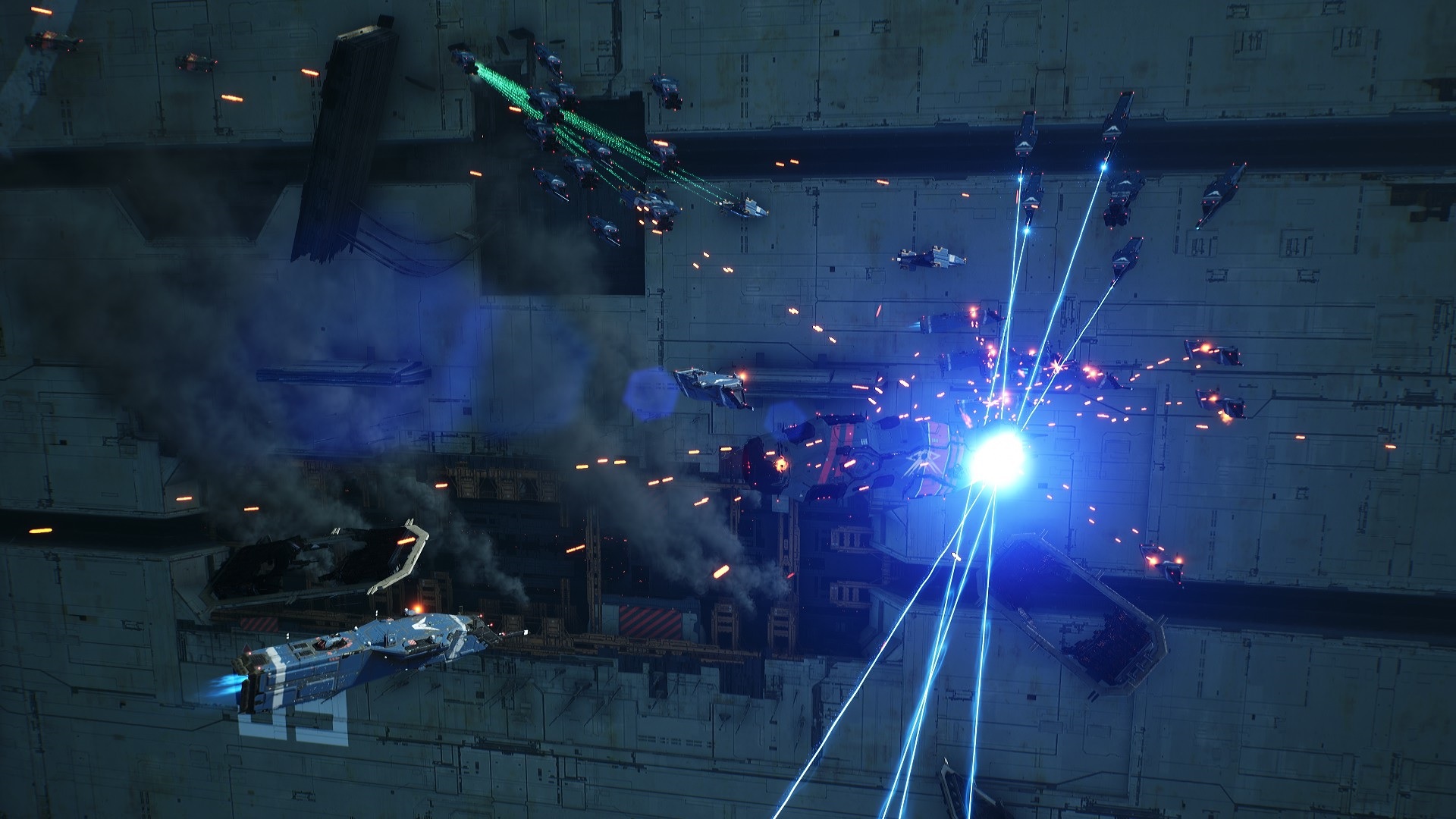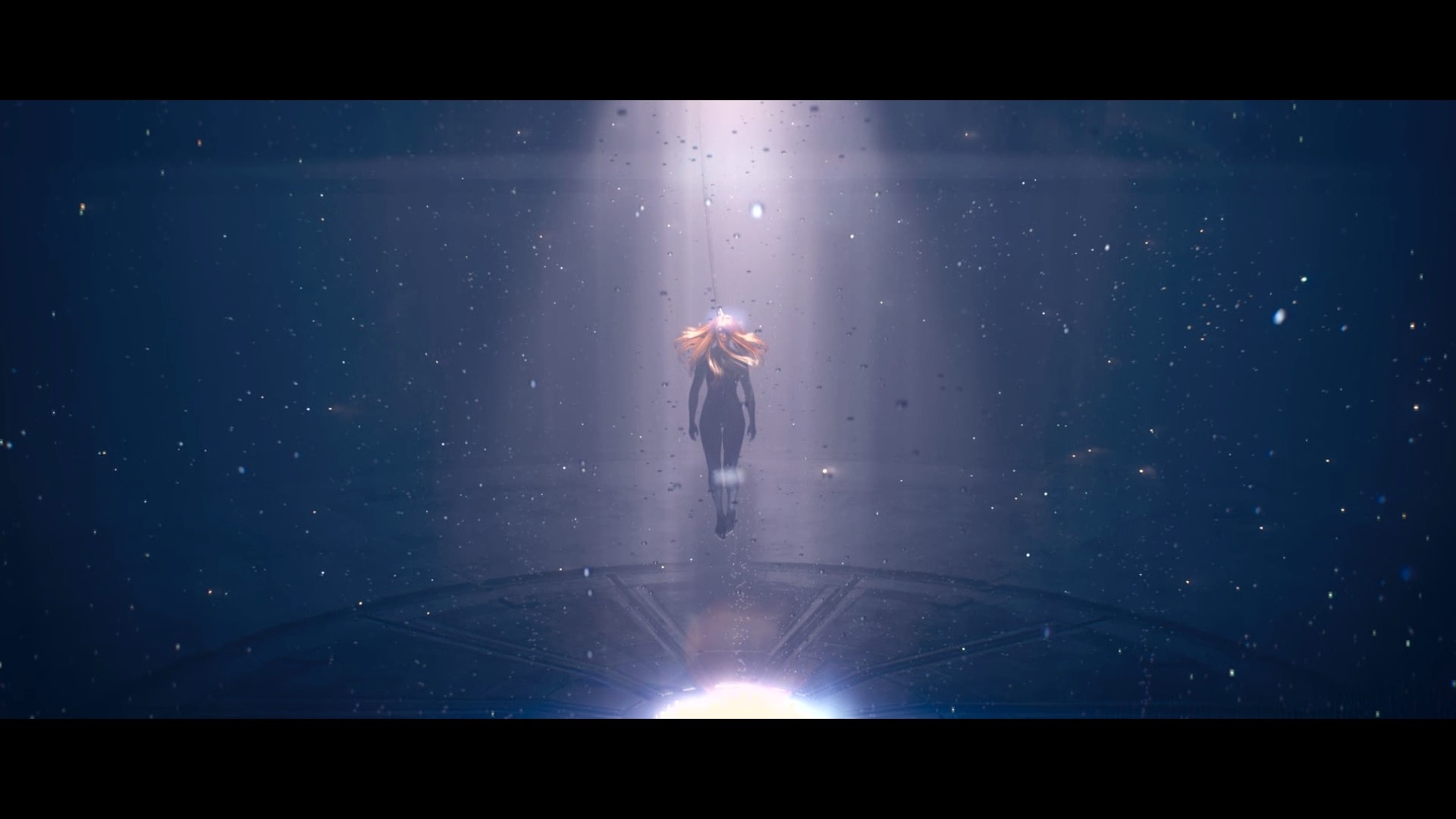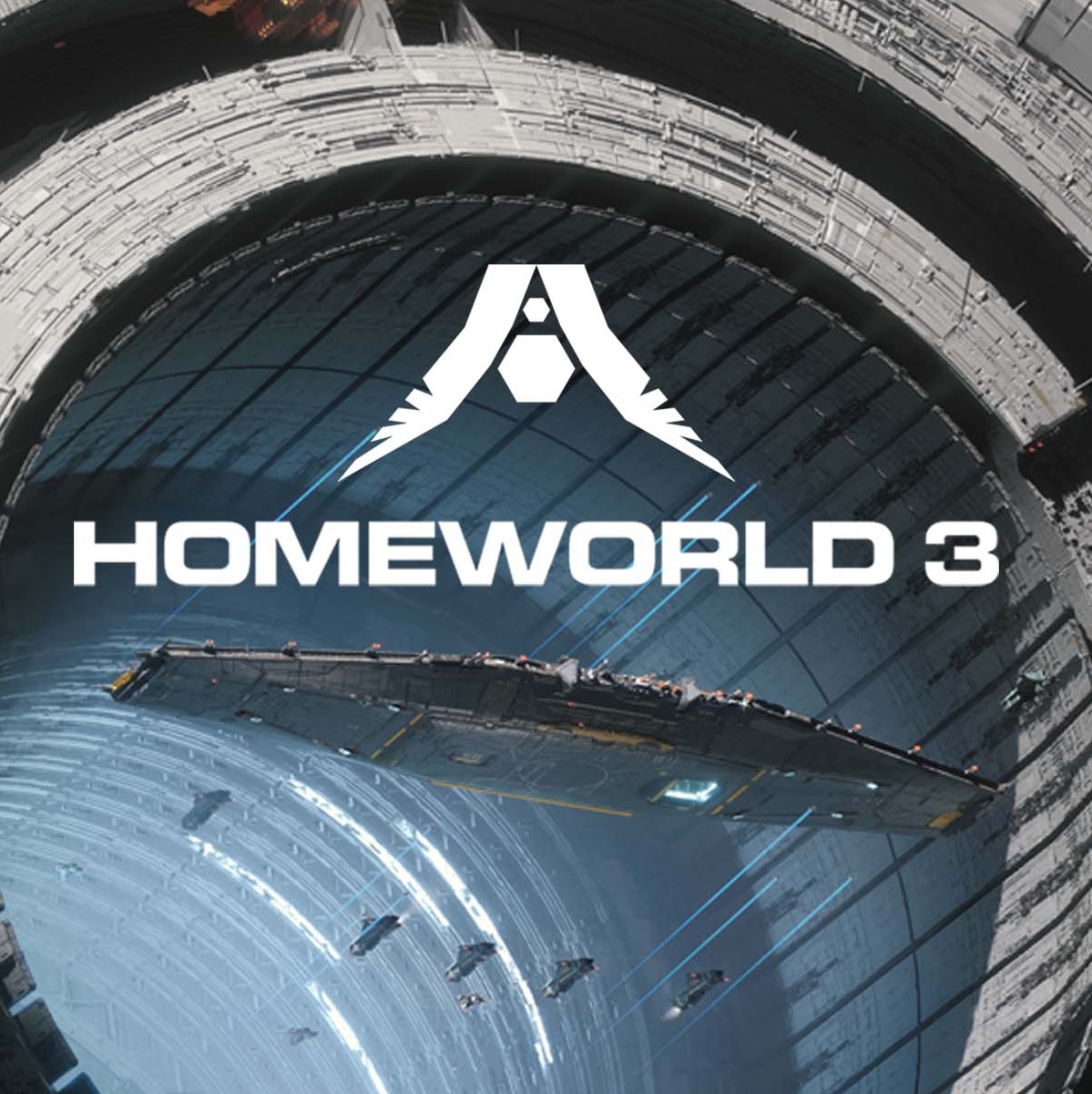As a handful of damaged torpedo frigates send shot after shot into the enemy destroyer’s bow, keeping its attention focused, my bombers come up from behind in a carefully executed maneuver that sees a volley reach the destroyer’s more lightly-armored aft, obliterating with ease.
So goes another encounter in Homeworld 3, a real-time strategy game I’ve been playing over the last couple of weeks. Over the course of the campaign and multiplayer modes, I’ve had fun building numerous fleets and pulling off victories against numerically-superior opponents while navigating through derelict wrecks and perilous zones of space.
Story-wise, not everything works perfectly, and I am left wishing the narrative was more even, as it concludes just as things really ramp up in interesting ways. Even so, the character work here rings true to the universe, with newcomer Imogen S’Jet proving her place in Homeworld as a whole, and after going through the campaign, I’m hopeful that this isn’t the last we’ve seen of her.
This review was made possible thanks to a review code provided by Gearbox Publishing. The company did not see the contents of this review before publishing.
What is Homeworld 3?
Homeworld 3
Price: $60 at GreenManGaming
Developer: Blackbird Interactive
Publisher: Gearbox Publishing
Genre: Real-time strategy
Install size: 30.6 GB
Playtime: 12+ hours
Platforms: Windows PC
Reviewed on: Windows PC
Release date: May 13, 2024
Xbox Game Pass: No
Homeworld 3 is a real-time strategy game developed by Blackbird Interactive and published by Gearbox Publishing. It’s the sequel to Homeworld 2, a game that was first released back in 2003. Homeworld and Homeworld 2 were developed by Relic Entertainment, with Blackbird Interactive first stepping into the franchise in 2016 with Homeworld: Deserts of Kharak, a prequel to the very first game.
Set 100 years after the events of its predecessor, Homeworld 3 sees the relatively stable galaxy come under threat from the mysterious Anomaly, a danger striking near the heart of Hiigaran territory. With the legendary Karen S’Jet disappearing 20 years ago, a new mothership, the Khar-Kushan, led by Imogen S’Jet, is dispatched to investigate and stop the Anomaly.
Across the campaign, Skirmish, and War Games (a roguelike co-op mode), players command fleets that range from small fighters to destroyers and carriers. Utilizing 3D space, you’ll have to defeat enemy fleets and fulfill various objectives, usually by holding or navigating to a particular point.
Homeworld 3 review: Story and characters
While there are a number of other characters at play, the central narrative of Homeworld 3 revolves around the back-and-forth interactions of Fleet Command Imogen S’Jet and Intel officer Isaac Paktu. With both of them leading a self-reliant expedition into the unknown, they’re forced to figure things out on the go with little-to-no information.
With this pair carrying the narrative, it would’ve been easy for the story to stumble as it’s not given many voices to carry it. Fortunately, both Imogen and Isaac are incredibly compelling, with the former providing the more far-reaching thoughts and the latter concerned with the immediate implications of any actions taken.
Both Imogen and Isaac are incredibly compelling, with the former providing the more far-reaching thoughts and the latter concerned with the immediate implications of any actions taken.
The more they verbally bounce off of each other, the more they grew on me. In particular, Imogen’s uncertainty at trying to live up to Karen’s example could’ve felt insulting or reductive, but, instead, it’s compelling, to the point that I found myself cheering internally as Imogen carefully pieces things together.
Where things do stumble a bit is in the way the greater narrative unfolds. The threat of the Anomaly isn’t particularly well-defined, which is fair since it is a mystery, but the balance is off. While it does conclude with a solid payoff — there’s one particularly big moment that feels downright reverential to the franchise as a whole — the story is left a bit too vague for a bit too long. It’s a natural consequence of the story’s structure and mystery, but the story only truly ramps up for the finale.
Homeworld 3 review: Gameplay and customization
Similar to the prior games, Homeworld 3 tasks players with managing a full fleet. The user interface (UI) is well-suited to the task, providing smooth controls for grouping different units and moving your ships through three-dimensional space. Chaining orders and quickly producing batches of new ships are made easy through hotkeys, and there are a number of options (including fully remappable controls) if something isn’t to your liking.
Fleet management essentially revolves around gathering resources and using said resources to construct your fleet. Early on, you’ll be limited to fighters and bombers, but new vessels open up over time, with turrets, frigates, destroyers, carriers, and battlecruisers adding different capabilities to your arsenal. Leveraging these different abilities is key, and using mine-layers to create dense defensive walls or assigning support frigates to keep an eye on your battlecruisers is necessary in order to prevail against enemy fleets.
New to Homeworld 3 is an advanced cover system, one that allows your ships to take advantage of the largest wreckage and debris scattered across derelict space stations. This means chaining orders is even more critical than in past titles, and pulling off careful plans to flank your enemies by utilizing 3D space feels great.
While the breadth of options usually works well, I did encounter a couple of movement-related bugs as time went on. Occasionally, I was unable to directly order my Resource Controllers to interact with harvestable materials. It’s not something that normally came up thanks to the hotkey option, but it became annoying when it happened and I needed to move them away from danger while getting the ships to start harvesting in a particular area.
Campaign
Homeworld 3’s campaign unfolds over the course of about 12 hours or so, though it could naturally be a bit faster or longer depending on your skill level, difficulty selection, and how thorough you intend to be in strip-mining a location of its available resources.
Returning in Homeworld 3 is the “persistent fleet” feature, meaning ships you build or capture from your enemies stay in your fleet until they’re destroyed. This has always added weight to the units in the Homeworld franchise, as they aren’t just replaceable copies. There are people piloting those ships which means that when you inevitably lose some of them, it can sting.
Pulling together a group of Ion Frigates into a wall formation matters more because I’ve had them for hours. Losing a destroyer in order to draw enemy fire hurts because that destroyer has been part of my fleet for the last three missions. When one scenario saw my fleet pull an emergency evacuation, I managed to get every ship out except a lone bomber. Dozens upon dozens of other friendly vessels were destroyed later on, but I’m still thinking about that bomber.
Homeworld 3’s campaign takes place over a series of different locations, which means there are some interesting setups that enhance or restrict your capabilities and make you adapt for a brief time. One particularly fun mission sees you moving your fleet below an ice shelf, racing against time to keep your mothership from being detected.
War Games and Skirmish
On the multiplayer side, there’s War Games and Skirmish mode. The latter is essentially what you’d expect, allowing you to take on a handful of other players (or AI opponents) in a quick-ish multiplayer fight over a variety of maps.
War Games however, is entirely new. This roguelike mode starts players with a single carrier and a handful of additional ships. From there, you have to quickly build up your forces and adapt to randomized objectives and maps, meaning no two runs are exactly the same. Ranking up by playing War Games means unlocking new starting fleet compositions, which adds a layer of meta-progression and can drastically change your options. This is a lot of fun, and I’m definitely looking forward to playing some War Games with my friends in the future.
While you can play this mode by yourself, I don’t recommend it for anyone but the most skilled players. War Games is explicitly geared around playing with others in co-op, and you’ll face ludicrous odds trying to make progress on your own. If the idea of trying to single-handedly hold off waves of destroyers and packs of enemy corvettes with no end in sight sounds great, be my guest, but I’ll be grabbing a friend or two.
Homeworld 3: Visuals and audio
Saying this game is absolutely gorgeous feels like a callous understatement. From watching space dust flow through a dense asteroid field and stark ice shelfs to colossal monoliths of fallen galactic might, the presentation of Homeworld 3 is imposing in a way that evokes images of Denis Villeneuve’s Dune films. Science-fiction media often struggles with communicating sheer scale, but that’s simply not the case here.
Watching fighter contrails weave into formations as frigates and destroyers thunder with heavy ranged artillery never ceases to be awe-inducing, while ion beams hum as they burn through the armor of larger support vessels in sights that are hauntingly beautiful. At every tangible touchpoint, Homeworld 3 is an audiovisual delight.
Science-fiction media often struggles with communicating sheer scale, but that’s simply not the case here.
The soundtrack — which was composed by returning Homeworld veteran Paul Ruskay — is appropriately mournful. It never revels in the thrill of combat, fading out as guns boom and energy weapons crackle. It takes time to marvel at the wonders and wounds of humanity, both new and forgotten.
With an RTX 3070 paired to an i7-13700KF, I was able to run Homeworld 3 maxed out at 1080p, while maintaining a steady 60 FPS most of the time. Even if your hardware isn’t as new, DLSS support allows a range of resolution scaling, and a wide configuration of computers should be capable of playing without issue.
The framerate did take a hefty hit in the final mission, regularly plummeting to 30 FPS or below, but this was also a point where there were hundreds of ships on screen at once with accompanying visual effects. With War Games and Skirmish modes also running without any performance hitches from my tests, that last mission seems to be an anomaly based on the absolute density of what’s happening.
Homeworld 3: Accessibility and approachability
Homeworld 3 features a full suite of accessibility options, with Blackbird Interactive providing settings for players to change faction colors, adjust the UI scale, and more. You can toggle ship health bars so you’ve always got them visible for ease of responsiveness, but you can also turn them off if they get too distracting in gameplay.
In the campaign, you’ll also have the option to pause or slow down the gameplay by increments of 25%, allowing more reaction time in larger-scale battles. For obvious reasons, this isn’t available when playing a mode like War Games online, but it’s still nice for helping less-experienced players adapt to the input overload of commanding a fleet for the first time.
The story is a bit more inaccessible for total newcomers. While the team has done a good job trying to make this an easy game to just hop into, it’s still the continuation of a narrative with multiple games of background material, and picking that up two decades later was always going to be a tall order. There is a lengthy recap video available that retells key events, but I would still recommend players check out Deserts of Kharak, Homeworld, and Homeworld 2 before playing Homeworld 3.
Should you buy Homeworld 3?
Homeworld 3 is a fun game, and bar a few small things here and there, it’s a smooth experience. While the story unfolds in a way that feels more than a bit unbalanced, it still resonates with some solid character writing, and I really hope we haven’t seen the last of Imogen and the crew of the Khar-Kushan.
With numerous planned updates in the coming months (both free and paid), there’s a solid roadmap for players to look forward to, especially for anyone that enjoys War Games. I’d certainly be happy to see a story expansion as well, but no matter what, this is one of the best PC games of the year.
At the end of it all, the experience of Homeworld 3 is a lot like the story of Imogen S’Jet. Both are struggling to live up to the impossible expectations of their predecessors, expectations that have grown exponentially in legend and reputation due to the passage of time. They make mistakes and errors. Even so, in the quieter moments, both manage to prove their worth over and over on their own terms.
Homeworld 3 launches early on May 10, 2024 for any Fig Backers, or anyone that bought the Fleet Command or Collector’s Edition of the game. For everyone else buying the standard or deluxe edition, Homeworld 3 launches on May 13, 2024.
Homeworld 3 is a long time coming, and it delivers a personal, character-focused campaign that’s open for newcomers but is sure to strike a chord with long-time veterans. With gorgeous visuals and advanced AI, a few rough spots don’t keep this from being a space strategy game well worth experiencing.


